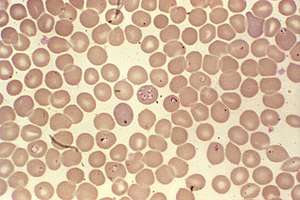Piroplasmida
| Piroplasmida | |
|---|---|
 | |
| Scientific classification | |
| Domain: | Eukaryota |
| (unranked): | SAR |
| (unranked): | Alveolata |
| Phylum: | Apicomplexa |
| Class: | Aconoidasida |
| Order: | Piroplasmida |
| Families and Genera | |
| |
Piroplasms (order Piroplasmida) are eukaryotic parasites of the phylum Apicomplexa.[2][3] They divide by binary fission and as sporozoan parasites they possess sexual and asexual phases (sexual reproduction occurs in the tick gut[4]). They include the tick parasites Babesia and Theileria.[5][6]
Description
They are minute rounded or pyriform parasites found within erythrocytes, or other circulating or endothelial cells of vertebrates, where they reproduce by merogony. The trophozoite stage is separated from erythrocyte by a single membrane. This distinguishes them from other blood parasites that usually have at least two membranes.
An apical complex with a polar ring and rhopteries occurs, but without a conoid and usually without associated pellicular microtubules. They lack flagella and do not form either oocysts or spores.
The known vectors are ticks or leeches in which they undergo sporogony; sexual reproduction probably occurs in the vector.
See also
References
- ↑ Manwell RD (1964). "The Genus Dactylosoma". The Journal of Protozoology. 11 (4): 526–530. doi:10.1111/j.1550-7408.1964.tb01792.x.
- ↑ Definition: piroplasmida from Online Medical Dictionary
- ↑ Flora and Fauna of the British Isles
- ↑ Rudzinska MA, Spielman A, Lewengrub S, Trager W, Piesman J. "Sexuality in piroplasms as revealed by electron microscopy in Babesia microti". Proc. Natl. Acad. Sci. U.S.A. 80 (10): 2966–70. doi:10.1073/pnas.80.10.2966. PMC 393954. PMID 6574467.
- ↑ Definition: Theileriidae from Online Medical Dictionary
- ↑ Theleriosis: The causal organism and life cycle